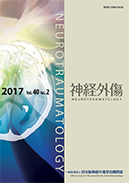Volume 40, Issue 2
Neurotraumatology
Displaying 1-8 of 8 articles from this issue
- |<
- <
- 1
- >
- >|
Original Article
-
Article type: research-article
2017Volume 40Issue 2 Pages 85-91
Published: December 20, 2017
Released on J-STAGE: April 27, 2020
Download PDF (3751K) -
Article type: research-article
2017Volume 40Issue 2 Pages 92-95
Published: December 20, 2017
Released on J-STAGE: April 27, 2020
Download PDF (2470K) -
Article type: research-article
2017Volume 40Issue 2 Pages 96-104
Published: December 20, 2017
Released on J-STAGE: April 27, 2020
Download PDF (4629K)
Case Report
-
Article type: case-report
2017Volume 40Issue 2 Pages 105-108
Published: December 20, 2017
Released on J-STAGE: April 27, 2020
Download PDF (3305K) -
Article type: case-report
2017Volume 40Issue 2 Pages 109-112
Published: December 20, 2017
Released on J-STAGE: April 27, 2020
Download PDF (3260K) -
2017Volume 40Issue 2 Pages 113-116
Published: December 20, 2017
Released on J-STAGE: April 27, 2020
Download PDF (2447K) -
Article type: case-report
2017Volume 40Issue 2 Pages 117-120
Published: December 20, 2017
Released on J-STAGE: April 27, 2020
Download PDF (3237K)
Commentary
-
Article type: other
2017Volume 40Issue 2 Pages 121-128
Published: December 20, 2017
Released on J-STAGE: April 27, 2020
Download PDF (2441K)
- |<
- <
- 1
- >
- >|
